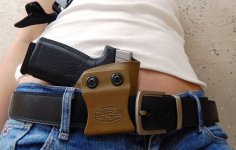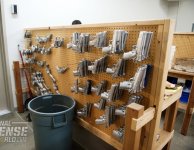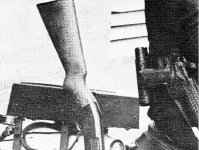rednichols
Member
- Joined
- Jul 24, 2012
- Messages
- 2,745
- Reaction score
- 8,484
I do virtually all my posting over on the gunleather forum. Nevertheless I reckon this particular topic might do more good here than there.
First, consider that holsters only exist because the pistol maker made them necessary; that is, they didn't provide for a way to get a handgun out of the hand whilst not shooting .
.
Second, consider that pistol makers give NO consideration to holsters when they develop a pistol; a very old case in point was the Smith M59 that had such a gigantic slide stop that it wouldn't allow pistols go into some holsters; and Smith declined to do anything about it until holsters started actually pushing the slide stops out of the pistol! Accessory makers, too -- trigger shoes were wider than the trigger guard and caused all kinds of discharges at the end of the last century.
Third, consider that holsters didn't always cover pistols' trigger guards; quite the opposite because access to the trigger was considered by the market to be necessary. For these holsters, it was DA autos and revolvers, SA revolvers, and Condition Three SA autos.
Fourth, consider that when guards began to be covered by holsters it was because of the 1911 suddenly being carried in Condition One (1970s); and attacks by BGs on holstered pistols became the norm. These pistols had/have external safeties and most holsters blocked the firing pins, except at a pistol range.
Fifth, consider that when holster makers were confronted with the new Glock-action type pistols, they assumed that this "Big Bear" paradigm should be applied to these, too. Been that way ever since, to the present day.
Trouble is, they didn't see this coming: my USA armourer (an experienced LEO with notches) sent this along to me the other day --
"Remember when I tested how obstructed the trigger had to be for the Glock to go bang in the Safariland duty holster? It got a real world test and failed:
Shooting during police funeral came from holstered gun - Local News - 13 WTHR Indianapolis ".
He and I began to do this testing because we DID see this coming. The above situation is mirrored by a very recent recall of 18,000 holsters here in OZ for that pistol and holster, when a struggle for the gun ended in a discharge: accessible trigger and no external safety.
I've had many an online dialogue with holster makers, and there is no awareness that the sand has shifted under their feet; nor any sense of responsiblity to you as users. And that is despite knowing that the 21st century trend is belly carry (incorrectly called appendix carry) with this type of action.
So I bring it to the attention of USERS; to increase awareness of what should have been an obvious risk, in case there are those who haven't fully considered it.
First, consider that holsters only exist because the pistol maker made them necessary; that is, they didn't provide for a way to get a handgun out of the hand whilst not shooting
Second, consider that pistol makers give NO consideration to holsters when they develop a pistol; a very old case in point was the Smith M59 that had such a gigantic slide stop that it wouldn't allow pistols go into some holsters; and Smith declined to do anything about it until holsters started actually pushing the slide stops out of the pistol! Accessory makers, too -- trigger shoes were wider than the trigger guard and caused all kinds of discharges at the end of the last century.
Third, consider that holsters didn't always cover pistols' trigger guards; quite the opposite because access to the trigger was considered by the market to be necessary. For these holsters, it was DA autos and revolvers, SA revolvers, and Condition Three SA autos.
Fourth, consider that when guards began to be covered by holsters it was because of the 1911 suddenly being carried in Condition One (1970s); and attacks by BGs on holstered pistols became the norm. These pistols had/have external safeties and most holsters blocked the firing pins, except at a pistol range.
Fifth, consider that when holster makers were confronted with the new Glock-action type pistols, they assumed that this "Big Bear" paradigm should be applied to these, too. Been that way ever since, to the present day.
Trouble is, they didn't see this coming: my USA armourer (an experienced LEO with notches) sent this along to me the other day --
"Remember when I tested how obstructed the trigger had to be for the Glock to go bang in the Safariland duty holster? It got a real world test and failed:
Shooting during police funeral came from holstered gun - Local News - 13 WTHR Indianapolis ".
He and I began to do this testing because we DID see this coming. The above situation is mirrored by a very recent recall of 18,000 holsters here in OZ for that pistol and holster, when a struggle for the gun ended in a discharge: accessible trigger and no external safety.
I've had many an online dialogue with holster makers, and there is no awareness that the sand has shifted under their feet; nor any sense of responsiblity to you as users. And that is despite knowing that the 21st century trend is belly carry (incorrectly called appendix carry) with this type of action.
So I bring it to the attention of USERS; to increase awareness of what should have been an obvious risk, in case there are those who haven't fully considered it.




